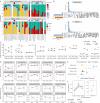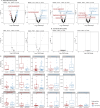Maternal balanced energy-protein supplementation reshapes the maternal gut microbiome and enhances carbohydrate metabolism in infants: a randomized controlled trial
- PMID: 40102379
- PMCID: PMC11920048
- DOI: 10.1038/s41467-025-57838-y
Maternal balanced energy-protein supplementation reshapes the maternal gut microbiome and enhances carbohydrate metabolism in infants: a randomized controlled trial
Abstract
Balanced energy-protein (BEP) supplementation during pregnancy and lactation can improve birth outcomes and infant growth, with the gut microbiome as a potential mediator. The MISAME-III randomized controlled trial (ClinicalTrial.gov: NCT03533712) assessed the effect of BEP supplementation, provided during pregnancy and the first six months of lactation, on small-for-gestational age prevalence and length-for-age Z-scores at six months in rural Burkina Faso. Nested within MISAME-III, this sub-study examines the impact of BEP supplementation on maternal and infant gut microbiomes and their mediating role in birth outcomes and infant growth. A total of 152 mother-infant dyads (n = 71 intervention, n = 81 control) were included for metagenomic sequencing, with stool samples collected at the second and third trimesters, and at 1-2 and 5-6 months postpartum. BEP supplementation significantly altered maternal gut microbiome diversity, composition, and function, particularly those with immune-modulatory properties. Pathways linked to lipopolysaccharide biosynthesis were depleted and the species Bacteroides fragilis was enriched in BEP-supplemented mothers. Maternal BEP supplementation also accelerated infant microbiome changes and enhanced carbohydrate metabolism. Causal mediation analyses identified specific taxa mediating the effect of BEP on birth outcomes and infant growth. These findings suggest that maternal supplementation modulates gut microbiome composition and influences early-life development in resource-limited settings.
© 2025. The Author(s).
Conflict of interest statement
Competing interests: The authors declare no competing interests. Inclusion & Ethics statement: The study was approved by the Commissie voor Medische Ethiek (CME) of Ghent University Hospital (protocol code: B670201734334 and date of 10/08/2020) and the Comité d’Éthique Institutionnel de la Recherche En Sciences de la Santé (CEIRES) of the Institut de Recherche en Sciences de la Santé (IRSS) (protocol code: 50-2020/CEIRES and date of 22/10/2020). An independent Data and Safety Monitoring Board (DSMB), which included an endocrinologist, two pediatricians, a gynecologist, and an ethicist from Belgium and Burkina Faso, was established prior to the trial. The DSMB managed remote safety reviews for adverse and serious events at nine and 20 months after the start of enrollment. The MISAME-III trial was registered on ClinicalTrials.gov (identifier: NCT03533712). The research was conducted in collaboration with local partners, including Agence de Formation de Recherche et d’Expertise en Santé pour l’Afrique (AFRICSanté) and IRSS. Researchers from AFRICSanté and IRSS who contributed to the research and fulfilled the authorship criteria were included as co-authors, while other team members, such as physicians and midwives who contributed to data collection, were acknowledged in the Acknowledgements section. Roles and responsibilities were agreed upon among collaborators ahead of the research initiation. A clear delineation of tasks and contributions was outlined in collaborative meetings and documented in written agreements to ensure effective coordination and execution of the study objectives. Additionally, capacity-building plans for local researchers were discussed and integrated into the research framework, including training sessions, knowledge-sharing initiatives, and authorship opportunities. The research does not lead to stigmatization, incrimination, discrimination, or personal risk for participants. Thorough risk assessments were conducted prior to the commencement of the research to identify and evaluate potential hazards and risks associated with various aspects of the study. These assessments considered factors such as environmental conditions, exposure to hazardous materials, and travel risks. Benefit-sharing measures have been discussed in the event that biological materials, cultural artifacts, or associated traditional knowledge are transferred outside the country. Local and regional research relevant to our study has been taken into account in our citations.
Figures







References
-
- UNICEF / WHO / World Bank Group. Levels and Trends in Child Malnutrition: UNICEF/WHO/World Bank Group Joint Child Malnutrition Estimates: Key Findings of the 2023 Edition. https://www.who.int/publications-detail-redirect/9789240073791 (2023).
-
- Black, R. E. et al. Maternal and child undernutrition and overweight in low-income and middle-income countries. Lancet382, 427–451 (2013). - PubMed
-
- Martorell, R., Khan, K. & Schroeder, D. G. Reversibility of stunting: epidemiological findings in children from developing countries. Revers. Stunt. Epidemiol. Find. Child. Dev. Ctries.48, S45–S57 (1994). - PubMed
-
- Victora, C. G., de Onis, M., Hallal, P. C., Blössner, M. & Shrimpton, R. Worldwide timing of growth faltering: revisiting implications for interventions. Pediatrics125, e473–e480 (2010). - PubMed
Publication types
MeSH terms
Substances
LinkOut - more resources
Full Text Sources
Medical

